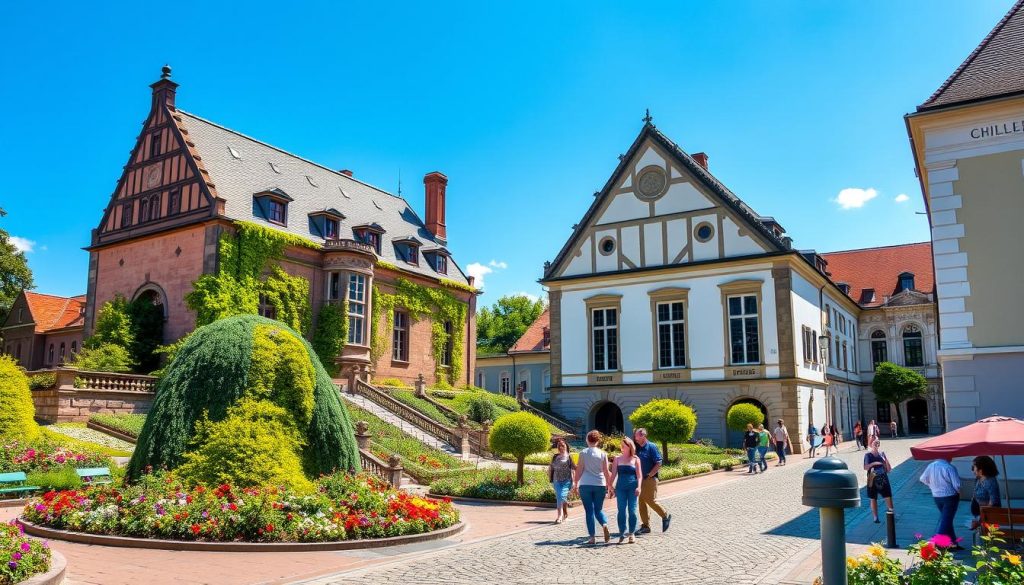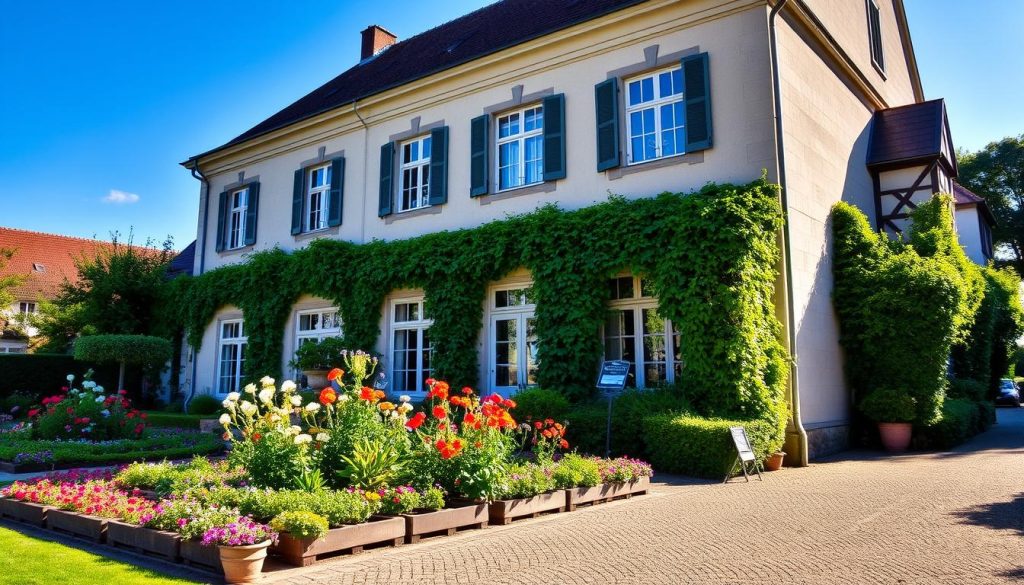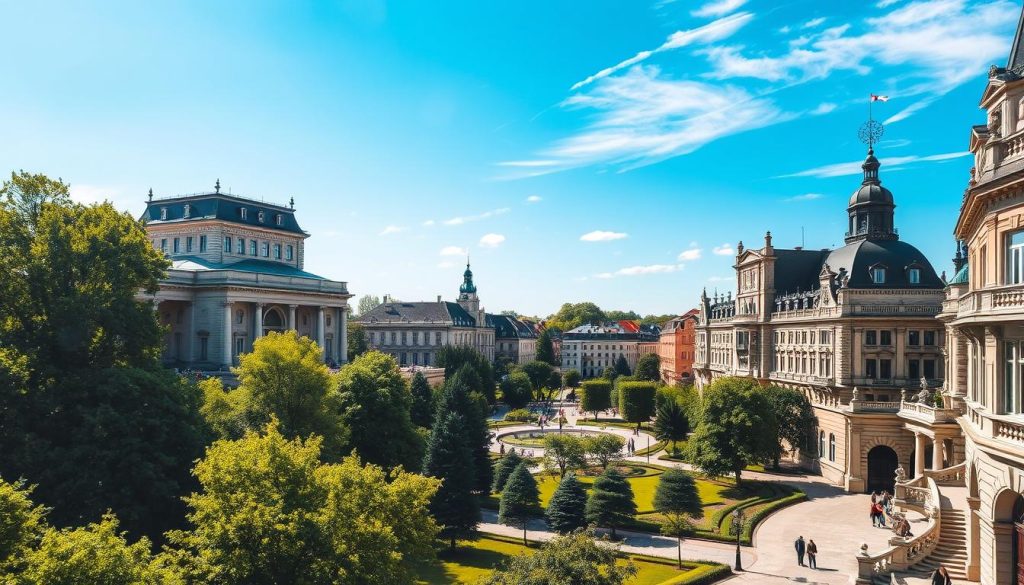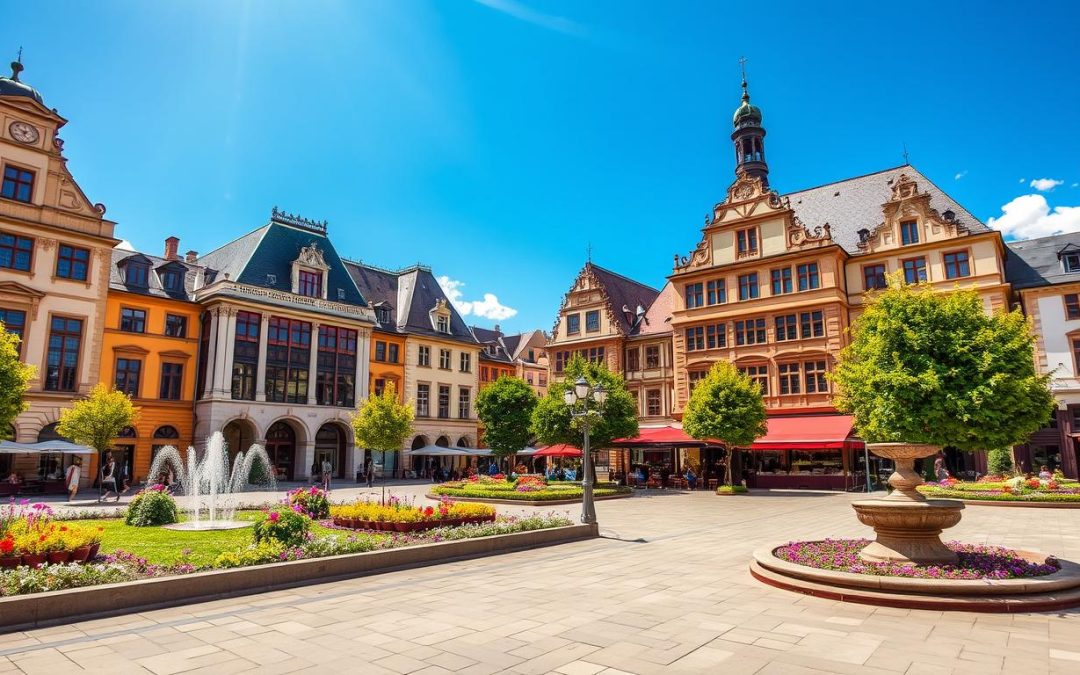Have you ever wondered where German culture and literary genius came together? Welcome to Weimar, a UNESCO World Heritage city. It’s a place where art and history meet.
In the heart of Thuringia, Weimar is a journey through Germany’s cultural heart. This small city is full of amazing sights. It’s perfect for history lovers, art fans, and curious travelers.
Here, you can see the homes of famous writers like Johann Wolfgang von Goethe and Friedrich Schiller. You’ll also find incredible buildings. Each place has a story of genius that shaped German culture.
Key Takeaways
- Explore a UNESCO World Heritage Site with exceptional cultural significance
- Discover the birthplace of German classical literature and art
- Visit legendary writers’ homes and museums
- Experience a compact city with immense historical importance
- Immerse yourself in Germany’s rich intellectual heritage
Discovering Classical Weimar’s Cultural Heritage
Weimar is in the heart of Germany and is a cultural gem. It was a hub of creativity and thought in the late 18th and early 19th centuries. This made it a key part of Classical Weimar.

Exploring Weimar, you see a world where creativity and knowledge meet. In 1998, UNESCO named Classical Weimar a World Heritage Site. This shows its huge impact on German culture.
The Birth of German Classicism
Weimar became a center of German Renaissance. It grew from a small duchy to a place of learning. Artists, thinkers, and writers came together, changing European ideas.
- Birthplace of influential cultural movements
- Home to revolutionary thinkers like Goethe and Schiller
- Center of artistic and philosophical innovation
UNESCO World Heritage Status
Weimar’s well-preserved history won it global fame. It has Goethe’s library and the Duchess Anna Amalia Library. These places take you back in time and show Germany’s cultural growth.
Literary Golden Age
Weimar’s golden age drew brilliant minds. Poets, philosophers, and artists made it a center of creativity. Their work still influences the world today.
“Weimar is not just a city, but a living museum of human creativity and intellectual pursuit.” – Cultural Historian
Goethe’s Legacy in Weimar
Weimar’s tourist spots are incomplete without Johann Wolfgang von Goethe’s impact. For 57 years, he made Weimar a hub of German literature and thought. His presence transformed the city.

Start your Goethe tour at his home on Frauenplan 1. The Goethe National Museum lets you see his world up close. It keeps his personal spaces just as he left them.
- Explore Goethe’s original study
- Discover his extensive art collections
- Browse through his personal library
The Garden House in Park an der Ilm offers another look into Goethe’s life. It was his quiet spot for inspiration and work.
“In Weimar, every stone tells a story of creativity and genius.” – Literary Historian
| Goethe Fact | Details |
|---|---|
| Years in Weimar | 57 years (1775-1832) |
| Major Contributions | Literature, Science, Theater |
| Notable Works | Faust, The Sorrows of Young Werther |
Goethe’s House is a key spot for fans of literature and history. His work still inspires people worldwide. Weimar is a cultural treasure for all to explore.
Essential Historical Sites and Attractions
Weimar is a key stop in Germany’s rich cultural journey. It’s home to remarkable UNESCO sites that show off literary and architectural genius.

Duchess Anna Amalia Library
The Duchess Anna Amalia Library is a dream for book lovers. It has over one million books and a stunning Rococo Hall. The woodwork and golden details make it a standout in Weimar’s UNESCO collection.
- Over 1 million historical volumes
- Breathtaking Rococo architectural design
- Significant research and preservation center
Goethe’s House and Garden
Go into the world of Johann Wolfgang von Goethe at his preserved home. This place gives you a close look at the life of a famous German writer. You’ll see rooms that inspired his works, with original furniture and personal items.
“A man sees in the world what he carries in his heart.” – Goethe
Schiller’s Residence
End your Weimar UNESCO sites tour at Friedrich Schiller’s home. Though smaller than Goethe’s, it offers a deep look into the poet-playwright’s life. The exhibits bring Schiller’s world to life, connecting you to Weimar’s literary past.
These sites are the heart of Weimar’s cultural heritage. They invite you to travel back in time and feel the intellectual brilliance that shaped German literature and arts.
The Bauhaus Movement and Modern History

Weimar’s culture goes beyond its classic roots. It was key in shaping modern design through the Bauhaus movement. This school, started in 1919, changed how artists and designers think.
“Design is not just what it looks like and feels like. Design is how it works.” – Walter Gropius, Bauhaus Founder
The Bauhaus in Weimar took a bold step in art and design education. It mixed practical crafts with fine arts, crossing old lines between art forms.
- Founded in Weimar in 1919
- Emphasized functional design
- Integrated multiple art forms
- Challenged traditional artistic boundaries
Places like the Bauhaus Museum in Weimar show the movement’s lasting impact. The museum features designs by famous artists like Marcel Breuer and Marianne Brandt.
| Bauhaus Key Figures | Contributions |
|---|---|
| Walter Gropius | School Founder, Architectural Visionary |
| Paul Klee | Artistic Instructor, Color Theory Expert |
| Wassily Kandinsky | Abstract Art Pioneer, Shape-Color Researcher |
In just 14 years, the Bauhaus movement changed global design. Its simple style and focus on art and industry inspire designers everywhere.
When you visit Weimar, check out Haus am Horn. It’s a prime example of Bauhaus design, showing the movement’s creative spirit.
Weimar, Germany: Best Things to Do – Top Picks
Weimar is a treasure trove of culture and history. Its small size and walkable streets make it easy to explore. Whether you love history or art, Weimar has something special for everyone.
Cultural Landmarks
Explore Weimar’s cultural heart. The city is home to 11 UNESCO World Heritage sites. Each site shares a unique story of art and intellect.
- Herder Church with its stunning Cranach altar
- Dower Palace (Wittumspalais), built in 1767
- Goethe’s Garden House near Ilm Park
Museums and Galleries
Weimar’s museums dive deep into its cultural past:
| Museum | Highlights | Year Established |
|---|---|---|
| Neues Museum Weimar | Modern art and design | 1869 |
| Goethe National Museum | 5,400 library volumes | Multiple exhibits |
| Bauhaus Museum | Design movement origins | 1919 |
Historical Buildings
Discover Weimar’s architectural gems:
- Duchess Anna Amalia Library – A stunning Rococo wonder
- Schiller Residence – Where the famous playwright lived from 1802-1805
- Goethe’s House – A 20-room tribute to the writer’s life
“In Weimar, every street tells a story, every building whispers historical secrets.” – Local Guide
Pro tip: Get the WeimarCard for €32.50. It gives you 48-hour access to many attractions. Most places are within walking distance, making it easy to explore.
Parks and Green Spaces in Weimar
Leave the historical streets behind and dive into Weimar’s beautiful green spaces. The city has parks that offer a break from cultural sights. They mix nature with history perfectly.
The Park an der Ilm is a highlight in Weimar. It’s an English-style park that follows the Ilm River. It’s not just a park; it’s a piece of Weimar’s cultural history.
“Nature is the only book that offers important content on every page.” – Johann Wolfgang von Goethe
Make sure to visit these amazing green spots during your Weimar trip:
- Park an der Ilm: Goethe’s favorite walking spot
- Belvedere Park: Spectacular baroque garden design
- Tiefurt Castle Gardens: Romantic 18th-century landscape
Each park offers something special. You can bike, have picnics, or just relax. They show Weimar’s dedication to nature and culture.
Pro tip: Wear comfy shoes and bring a camera. You’ll want to capture the beauty of these historic parks!
Architecture and Design Heritage
Weimar’s buildings tell a story of creativity and innovation. Walking through the city, you see a mix of old elegance and new ideas. This mix has earned Weimar its UNESCO World Heritage status.
Classical Architecture: Timeless Elegance
Classical Weimar is home to architectural wonders. These buildings show the city’s deep cultural roots. They blend Renaissance and Baroque styles, creating beautiful stories in stone and brick.
- Residence Castle: A stunning example of Renaissance design
- Wittumspalais: Elegant 18th-century architectural marvel
- Baroque-style public buildings showcasing intricate details
Bauhaus Influence: Modernist Revolution
Weimar is where the Bauhaus movement began. Founded in April 1919 by Walter Gropius, it changed how buildings are made. The Bauhaus school brought new ideas to architecture.
| Bauhaus Landmark | Year | Significance |
|---|---|---|
| Bauhaus Museum | 2019 | Showcases world’s largest Bauhaus collection |
| Haus am Horn | 1923 | First experimental Bauhaus design house |
| Main University Building | Early 1920s | Iconic modernist architectural example |
Modern Preservation: Protecting Heritage
Weimar UNESCO sites show a strong commitment to keeping buildings safe. The city works hard to keep its history alive. At the same time, it welcomes new designs.
“Architecture is the truly democratic art, as it creates the environment in which people live.” – Walter Gropius
Weimar finds a balance between keeping its past alive and embracing new ideas. This makes it a special place for those who love architecture.
Art and Cultural Experiences
Dive into Weimar’s vibrant cultural scene, where art and heritage blend seamlessly. Your Weimar travel guide reveals a world of artistic experiences. These experiences capture the essence of the city’s rich cultural heritage.
The city offers an extraordinary array of artistic encounters. These encounters bring history to life. At the heart of Weimar’s cultural landscape is the German National Theater.
Here, world-class performances transport you to another era. Classical music enthusiasts will find themselves captivated by the Staatskapelle Weimar. This renowned orchestra has deep historical roots.
- Experience classical concerts at the historic German National Theater
- Explore contemporary art exhibitions
- Participate in cultural workshops
- Take literary walks in Goethe and Schiller’s footsteps
“Art is not a luxury in Weimar, but a way of life.” – Local Cultural Historian
The city’s artistic landscape reflects its incredible cultural depth. Consider these remarkable cultural statistics that showcase Weimar’s artistic brilliance:
| Cultural Highlight | Details |
|---|---|
| Literary Production | 38,000 books published by 1927 |
| Artistic Movements | Significant representation of Neue Sachlichkeit movement |
| Exhibition Scope | Over 100 paintings and drawings from 1920s German artists |
Your journey through Weimar’s art scene promises an immersive experience. This experience connects you directly with Germany’s most innovative cultural period. From museums to live performances, you’ll discover a city where creativity knows no boundaries.
Conclusion
Your Weimar travel guide journey shows a city that goes beyond usual tourist spots. It mixes history with culture, giving travelers a deep dive into Germany’s urban heart. You’ll see literary landmarks and architectural marvels, diving into German heritage.
Every part of Weimar has a story to tell. You can walk through UNESCO sites or visit the homes of Goethe and Schiller. This city’s small size makes it easy to explore, letting you soak in its cultural depth.
Planning your visit is key. Spring and early autumn are the best times for outdoor fun and history. Spending three to four days here lets you see museums, parks, and landmarks without rushing.
Weimar is more than a place to visit—it’s a living museum of German culture. Your trip here connects you to key moments in art, literature, and social change. With its mix of history and modern life, Weimar offers a journey that broadens your view of German history and culture.
The above is subject to change.
Check back often to TRAVEL.COM for the latest travel tips and deals.
Here are some Tours & Sightseeing suggestions that might pique your interests!
